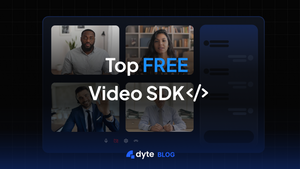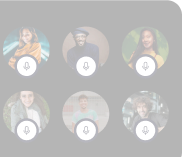Are you on the hunt for video SDKs to elevate your applications with top-notch video communication features without stretching your budget? Look no further! We've curated a list of budget-friendly video SDKs that promise flexibility and customization. Let's dive right in!
Essential Features in Every Video SDK
Before we delve into the list of open-source video SDKs, let's highlight the indispensable features of a video SDK you should be on the lookout for:
- Multi-Party Video Calls: Facilitate group video calls, meetings, and webinars.
- Screen Sharing: The prowess to share screens for presentations and collaborations.
- Virtual Backgrounds: The flair to switch backgrounds to resonate with remote work ambiance.
- Real-Time Messaging and Whiteboards: Instruments for frictionless collaboration.
- Robust Security: Guarantee data protection and adherence to standards like HIPAA, GDPR, and SOC2.
- Compatibility: Seamless operation across devices (mobile, desktop, tablet) and operating systems (Windows, macOS, Linux).
- Customizability: A palette of options to mold the UI and video calls to mirror your brand or team's aesthetics.
List of Free Video SDKs
Let's navigate through a list of open-source video SDKs like Ziggeo SDK, Kurento, Licode, Kite, Ant Media Server, Jitsi, Jibri, and Big Blue buttons.
We'll evaluate features and drawbacks of each of the following free video SDKs:
- Ziggeo SDK
- Kurento
- Licode
- KITE
- Ant Media Server
- Jitsi VideoBridge
- Jibri
- BigBlueButton
Ziggeo Video SDK
Ziggeo is a video SDK that furnishes video recording and playback functionalities. It assists developers in integrating video attributes into their applications. Ziggeo might not boast all the advanced features, but it's a nimble and budget-friendly pick for rudimentary video functions.
Ziggeo's Features:
- Video recording and playback.
- Adaptable video player.
- Scalability without a hitch.
Ziggeo's Shortcomings:
- A limited suite of advanced features.
- Customization might be a tad restrictive.
- Scalability could pose challenges for high-demand applications.
- Integration with specific platforms might demand extra elbow grease.
- Add-on options might be limited compared to more holistic solutions.
Kurento SDK
Kurento is a media server that helps in real-time video and audio communication. It offers features like computer vision and augmented reality.
Kurento's Features:
- Real-time video and audio communication.
- Mastery in computer vision and augmented reality.
- Adaptable for a myriad of application scenarios.
Kurento's Shortcomings:
- Mastery is essential to tap into its full potential.
- Some platforms might pose integration challenges.
- Its advanced suite might present a steeper learning curve.
Licode SDK
Licode, a WebRTC media server, for applications requiring real-time communication features. However, it's documentation can we a maze for some, especially if you are just getting started.
Licode's Features:
- WebRTC-centric real-time communication.
- Video conferencing and collaboration tools.
- Open-source with customization at its core.
Licode's Shortcomings:
- A slightly steeper learning curve due to its intricate documentation.
- Advanced features might be limited.
- Customization and integration could be a challenge for some.
KITE Video SDK
KITE, or Keynote Integration Testing Environment, is not your conventional video SDK. However, it's an invaluable open-source tool for testing and assuring the quality of your WebRTC applications. KITE is your compass to validate the performance and reliability of your video communication suite.
KITE's Features:
- Testing and validation of WebRTC applications.
- Performance and reliability assessment.
KITE's Shortcomings:
- It's not your typical video SDK; it's test-centric.
- Mastery might be required to interpret results effectively.
Ant Media Server
Ant Media Server, an open-source media server, champions WebRTC-based video streaming and conferencing. It fairs pretty well when it comes to scalability and customization. However, its documentation might be a puzzle for some.
Ant Media Server's Hallmarks:
- WebRTC-driven video streaming and conferencing.
- Scalability to accommodate a growing user base.
- Low latency in video streaming.
- Adaptive bitrate streaming for optimal video quality.
Ant Media Server's Shortcomings:
- Documentation might be cryptic for some.
- Functionality might have its quirks.
- Large-scale deployments might require fine-tuning.
- The community version might not encompass all features of the enterprise variant.
- Integration with certain platforms might be labor-intensive.
6. Jitsi Videobridge
Jitsi Videobridge, an open-source Selective Forwarding Unit (SFU) for WebRTC, is pivotal for multi-user video conferencing. It acts as a conduit, relaying video streams among participants without amalgamating them. However, it possesses some limitations regarding scalability, security, and customizations.
Jitsi Videobridge's Hallmarks:
- Open-source SFU for WebRTC.
- Multi-user video conferencing.
- Seamless integration with the Jitsi ecosystem.
Jitsi Videobridge's Shortcomings:
- Scalability might be a hurdle in expansive deployments.
- Analytical support might be sparse.
- The user interface might not resonate with all.
7. Jibri
Jibri, designed to record and stream Jitsi Meet conferences, integrates flawlessly with the Jitsi Meet ecosystem. It's your tool for recording and streaming video conferences.
Jibri's Hallmarks:
- Seamless integration with Jitsi Meet.
- Recording and live streaming functionalities.
- Open-source, allowing for exploration and customization.
Jibri's Shortcomings:
- Primarily effective within the Jitsi Meet framework.
- Each session demands dedicated resources.
- Setup might be intricate for novices.
8. BigBlueButton
BigBlueButton, tailored for online learning and collaboration, is your open-source web conferencing system.
BigBlueButton's Hallmarks:
- Tailored for online learning and collaboration.
- Video conferencing, screen sharing, and real-time collaboration.
- Breakout rooms, polls, and interactive whiteboards.
BigBlueButton's Shortcomings:
- Customization might be essential for non-educational scenarios.
- Technical prowess is a must for setup and upkeep.
- Advanced features might present a learning curve.
A Snapshot of the Best Free Video SDKs
| SDK Name | Description | Features | Limitations |
|---|---|---|---|
| Ziggeo | Video SDK offering video recording and playback. | - Video recording and playback. - Adaptable video player. | - Limited advanced suite. - Restrictive customization. |
| Kurento | Media server with a focus on real-time video and audio. | - Real-time video and audio. - Computer vision and AR. | - Mastery required. - Advanced suite might be intricate. |
| Licode | WebRTC media server for video-centric applications. | - WebRTC-driven communication. - Video conferencing. | - Slightly steeper learning curve. - Limited extensibility. |
| KITE | Tool for testing WebRTC applications. | - Testing and validation. - Performance assessment. | - Not a conventional video SDK. - Mastery for interpretation. |
| Ant Media Server | Media server with WebRTC streaming. | - WebRTC streaming. - Scalability. | - Cryptic documentation. - Quirks in functionality. |
| Jitsi Videobridge | SFU for WebRTC with multi-user video conferencing. | - SFU for WebRTC. - Multi-user video conferencing. | - Scalability hurdles. - Sparse analytical support. |
| Jibri | Tool for recording and streaming Jitsi Meet conferences. | - Integration with Jitsi Meet. - Recording and streaming. | - Effective within Jitsi Meet. - Demands dedicated resources. |
| BigBlueButton | Web conferencing system for online learning. | - Online learning. - Video conferencing. | - Customization for non-educational scenarios. - Technical prowess for setup. |
Wrapping Up
Embarking on the quest for the best free video SDKs and APIs mandates a keen eye for your unique needs, budget constraints, and your team's expertise. Each SDK and API is unique in its own right, with its strengths and limitations. Hence, a deep dive into research is paramount.
Yes, there are a lot of good free video SDK platforms out there, but they possess some common limitations like scalability, customization, and security. That's where Dyte's secure, reliable, and lightweight Video SDK stands out. You get 10K free credits each month with Dyte, so start building or talk to our product experts.
Bonus: If you are a startup, you can also apply for the startup program with Dyte and get an additional benefit




